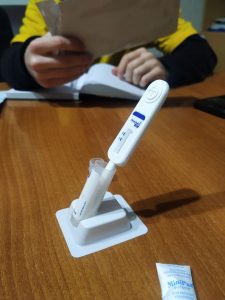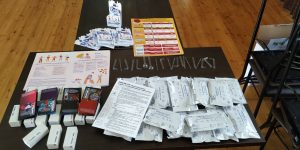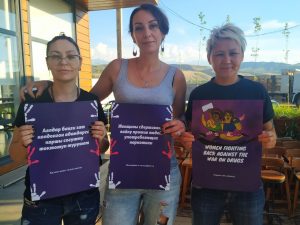Key facts
- NSP is introduced in the country in 1999. The next year, first NSPs are established in selected prisons in Kyrgyzstan; in 2008, OST starts being provided in prisons, at Colony No. 47 in Bishkek.
- In 2018, Kyrgyzstan stated drug use would be decriminalised under the new Criminal Code; however, the implementation and impact of reforms need to be further assessed as at present, the minimal fine for drug possession is the equivalent to 18 months’ salary.[1]
| Population | 6,389,500 [2] |
| PWID | 25,000 [3] |
| OST | Available in 31 operational sites.[4] |
| NSP | Available in 40 operational sites.[5] |
| HIV | Prevalence among PWID – 14,3%.[6] |
| Hepatitis C | Prevalence among PWID – 43,9%.[7] |
| Hepatitis B | No data. |
| Tuberculosis | — |
| Overdose prevention | Naloxone is not accessible in the pharmacies at all, or without prescription, but ambulances/hospitals have it; it is also possible to get it in harm reduction services. In 2013, a pilot naloxone programme was launched, where people who inject drugs were trained in overdose prevention and naloxone use. Over the course of the pilot, 81.5% of participants reported receiving naloxone to reverse an overdose.[8] |
| HR in closed settings | · OST is available in prisons. [6] |
| Criminalization costs[10]: | · Money spent on a prisoner/per year – €1,091.35 · Money spent for harm reduction and social services – €466 · Average sentence for drug law offenses – up to 6 years |
| Drug laws | · Consumption of drugs in public places is an administrative offence, punishable by 10 fine units (€13), plus eight hours of community service. [11] |
Please let us know about any errors or updated information in your country by email info@harmreductioneurasia.org, subject “Country profiles”
The priority for drug policy in Kyrgyzstan is to reduce supply and combat illegal drug trafficking. In this framework the problem of substance use, requiring effective social and health care interventions, is of secondary importance and remains underfunded. However, in comparison with other countries of Central Asia, this did not prevent Kyrgyzstan to stay for many years a pioneer state in Central Asia in the implementation of harm reduction programs, including programs in the penitentiary system.
Harm reduction and HIV among people who use drugs
 To reduce the prevalence of HIV Kyrgyzstan from the very beginning used harm reduction approaches and active cooperation with international donors and non-governmental organizations. The estimated number of people living with HIV in Kyrgyzstan today is 9,516. Despite the decline in the proportion of people who use drugs – slightly less than 45.1% – they continue to determine the nature of HIV prevalence in the country.
To reduce the prevalence of HIV Kyrgyzstan from the very beginning used harm reduction approaches and active cooperation with international donors and non-governmental organizations. The estimated number of people living with HIV in Kyrgyzstan today is 9,516. Despite the decline in the proportion of people who use drugs – slightly less than 45.1% – they continue to determine the nature of HIV prevalence in the country.
Kyrgyzstan became the first country in the region to actively implement harm reduction programs since 1999. Since 2002, syringe exchange points (needle and syringe programs (NSPs)) have become available in prisons. Today, harm reduction programs in Kyrgyzstan are experiencing problems as international donors reduced their funding. “We used to have 46 syringe exchange points,” says Aybar Sultangaziev, head of the Partnership Network Association. – Today, there are about 20 left, including those in the penitentiary system. So their number has been reduced by half. We used to have drop-in centers, shelters, rehabilitation centers – now all of them are closed.”
 The situation with the change in the drug scene in general and with COVID-19, in particular, has shown that harm reduction programs currently require revision of the list and quality of services they provide. So, if earlier the use of traditional drugs was associated with injecting, nowadays, smoking and sniffing are more common when using new psychoactive substances (NPS).
The situation with the change in the drug scene in general and with COVID-19, in particular, has shown that harm reduction programs currently require revision of the list and quality of services they provide. So, if earlier the use of traditional drugs was associated with injecting, nowadays, smoking and sniffing are more common when using new psychoactive substances (NPS).
However, service providers did not react to these changes by any means, and the range of services remains the same. “There was no heroin for two years, now there are virtually no heroin users,” says Sergey Bessonov executive director of the Harm Reduction Network Association. “But they cannot wait for two years. Some people switched to “salt”, some to methadone, some to alcohol, and some people quit. However, such gaps remain entirely invisible within the Global Fund program!” It is particularly evident in the work of NSPs, which still offer needles and syringes as the primary harm reduction service, but it does not meet the needs of people who use NPS.
One of the reasons for the inability to update the list of harm reduction services is the lack of access to the community of people who use NPS. “Recently, we’ve recommended to our networks and organizations to make changes in their teams of outreach-workers and other personnel. It is mandatory to employ representatives of this new generation of people who use drugs and have access to these groups,” Aybar Sultangaziev says.
Opioid agonist treatment
Opioid agonist treatment (OAT) with methadone was introduced in the country in 2002. Buprenorphine has not been registered in the republic to date. Since there are no budget funds for OAT in Kyrgyzstan, all OAT programs in the country are still supported by external funding. Today there are 24 OAT points in the republic. Four OAT points have been closed recently.
In Kyrgyzstan, a total of 981 people use OAT services, including those in the penitentiary system. Over the past few years, the number of clients of methadone programs not only did not grow but even significantly decreased. Since the country continues to maintain a drug user registry (minimal registration term is 3 years) that is inherited from the Soviet times, it automatically applies to all OAT clients. Consequently, the diagnosis of drug addiction can be the reason for deprivation of parental rights, barriers to finding a job and obtaining a driver’s license, etc. Such a situation does not contribute to the desire of patients to seek help from state OAT programs.
Another reason for the low popularity of OAT programs is mosly due to the changes in the drug scene that happened in the country in just two years when traditional drugs such as opium and heroin disappeared, and NPS have emerged on the market.
Some parliamentarians, law enforcement officials, and journalists periodically oppose the ongoing work of OAT programs in Kyrgyzstan. To a certain extent, their opinion is influenced by the position expressed by Russian officials and the media. According to Sergey Bessonov, now the main structure into which Kyrgyzstan is integrated is the Eurasian Economic Union (EAEU). “In EAEU, all members are oriented towards Russia. Moscow “rules” there. Russia does not recognize the substitution therapy program. And they informally promote their policies here. Everything that happens here is with an eye in the Russian direction. It definitely can be felt.”
Harm reduction in prisons
Since 2008, OAT has also been available in the Kyrgyz penitentiary system. Nowadays, 9 out of 24 OAT points operate in prisons. More than 350 clients receive services there. At the same time, OAT programs do not have an adequate level of acceptance among prisoners, as being in the program is considered a sign of weakness and dependence on the state system. Consequently, if an OAT client gets arrested for something, he/she abruptly attempts to quit the program.
“He or she needs to enter the prison without the status of a person who use methadone,” says Sergei Bessonov. “If these barriers to methadone were removed, the number of 350 people on OAT would turn into at least 700.”
COVID-19
The situation with COVID-19 changed the NSP and OAT programs. Syringe exchange points shifted to a simplified operation mode under which outreach workers started to receive preventive supplies for their clients for one month (previously, before the lockdown, they received them for one week). The NSP staff themselves switched to a remote mode of working.
Before the pandemic, those clients who had proven their adherence to the program and did not miss their daily doses for six months could get take-home methadone for up to 5 days. With the introduction of lockdown restrictions, OAT programs started to provide take-home doses to everyone without exception for up to 5 days. Aybar Sultangaziev sees no reason to stop this practice in the future. However, the Ministry of Internal Affairs could attempt to do so. Its competence includes the circulation of potent substances, so the Ministry is not interested in methadone provision under the new regulations. In this case, joint efforts of non-governmental and community organizations are necessary for protecting a new practice of OAT provision to clients for up to 5 days to all.
The republic does not have its production of NPS, such as mephedrone and Alfa-PVP. Therefore, these substances are entirely imported from Kazakhstan. For this reason, the closure of borders between Central Asian countries in 2020 due to COVID-19  led to a complete halt in the synthetic substances trade in Kyrgyzstan. The border closures forced dealers to sell drugs leftovers from stocks at 3–5 times higher prices. And then they completely stop all sales until the lifting of restrictions. Due to the lockdown in general, drug consumption in the country has decreased. Some people who use drugs have switched from using certain drugs to another. For example, some people have started using cannabinoids or pharmaceutical drugs, and alcohol, as they are more accessible in terms of availability and cost. As soon as the border between Kyrgyzstan and Kazakhstan reopened, drug trafficking and sales resumed, and NPS prices quickly returned to their previous level.
led to a complete halt in the synthetic substances trade in Kyrgyzstan. The border closures forced dealers to sell drugs leftovers from stocks at 3–5 times higher prices. And then they completely stop all sales until the lifting of restrictions. Due to the lockdown in general, drug consumption in the country has decreased. Some people who use drugs have switched from using certain drugs to another. For example, some people have started using cannabinoids or pharmaceutical drugs, and alcohol, as they are more accessible in terms of availability and cost. As soon as the border between Kyrgyzstan and Kazakhstan reopened, drug trafficking and sales resumed, and NPS prices quickly returned to their previous level.
Services for women who use drugs

The number of women who use drugs in Kyrgyzstan is 12% (3000) of the total estimated 25,000 people who use drugs. As in many other countries of Central Asia, in the republic, women are exposed to various forms of gender-based violence from their partners, close people, and the police. They experience stigma and discrimination from health-care providers in medical institutions. Since 2013, in Kyrgyzstan, the ‘Wings of Hope’ project has been implemented based on the WINGS (Women Initiating New Goals for Safety) screening tool developed at Columbia University. WINGS is a highly adaptable, evidence-based tool for screening, short-term intervention, and referring to treatment. It is designed to identify and address intimate partner violence and gender-based violence among women at risk. Intervention helps women to develop safety strategies and strengthen social support networks.

Since May 2019, crisis centers in such cities as Osh, Bishkek, Karakol, and Naryn have been implementing a pilot project (WINGS SUNFLOWER) in the country. The project makes provisions for developing a mechanism to assist women who suffered violence using the “one-stop-shop” method. However, harm reduction services are not gender-sensitive and do not meet the needs of female clients. There is no funding for childcare issues, instrumental diagnostics, and examinations by specialist physicians under existing harm reduction programs. Women also face some gender barriers when receiving detoxification (detox), rehabilitation, OAT, and other services.
Drug laws
In 2019 Kyrgyzstan adopted new legislation on drug-related crimes since the problem of psychoactive substance use remains relevant for the country. Several national codes have undergone amendments in the course of the overall judicial reform in the country.
 According to the new Administrative Liability Code (Misdemeanor Code), fines for small amounts of drugs (up to 1 g of heroin and up to 3 g of hashish) have increased thirty-fold: from 12-25 euros to 370–750 euros. An offender must pay the fine within three months. If the person fails to pay, the amount automatically doubles. In this case, he or she must pay the fine within a month. Otherwise, the person faces a prison sentence. Under the new Penal Code, possession of drugs without the purpose of sale in a large amount exceeding 1 gram for heroin and 3 grams for hashish is punishable by a fine of up to 3250–3750 euros. Previously, the penalty was a fine of 250 to 650 euros or imprisonment for up to five years. At the same time, the largest number of detentions and subsequent sanctions to date has to do with the possession of marijuana and hashish.
According to the new Administrative Liability Code (Misdemeanor Code), fines for small amounts of drugs (up to 1 g of heroin and up to 3 g of hashish) have increased thirty-fold: from 12-25 euros to 370–750 euros. An offender must pay the fine within three months. If the person fails to pay, the amount automatically doubles. In this case, he or she must pay the fine within a month. Otherwise, the person faces a prison sentence. Under the new Penal Code, possession of drugs without the purpose of sale in a large amount exceeding 1 gram for heroin and 3 grams for hashish is punishable by a fine of up to 3250–3750 euros. Previously, the penalty was a fine of 250 to 650 euros or imprisonment for up to five years. At the same time, the largest number of detentions and subsequent sanctions to date has to do with the possession of marijuana and hashish.
Nevertheless, the changes have several positive aspects. The main one is the reduction of criminal sentences for drug-related crimes. But even with this in mind, we cannot ignore the fact that the practical implementation of these changes contributes to the poverty of people who use drugs and their families, as well as leads to an increase in the number of prisoners.
Thus, the situation in Kyrgyzstan shows that ongoing harm reduction programs under the HIV strategy and the reform of drug legislation do not take into account the real needs of people who use drugs. Such a policy results in the low effectiveness of HIV prevention and even greater criminalization of people who use drugs in Kyrgyzstan.
[1] Harm Reduction International. Global State of Harm Reduction 2018.Available from: https://www.hri.global/files/2018/12/10/Eurasia-harm-reduction.pdf
[2] National Statistical Committee of the Kyrgyz Republic (2019). Available from: http://www.stat.kg/en/statistics/naselenie
[3] Harm Reduction International. Global State of Harm Reduction 2018.Available from: http://cadap-eu.org/upload/file/CSS_Kyrgyzstan_2018_03_online_final.pdf
[4] Harm Reduction International. Global State of Harm Reduction 2018.Available from: https://www.hri.global/files/2018/12/10/Eurasia-harm-reduction.pdf
[5] Harm Reduction International. Global State of Harm Reduction 2018.Available from: https://www.hri.global/files/2018/12/10/Eurasia-harm-reduction.pdf
[6] CADAP. Country overview of drug situation. Kyrgyzstan, 2018. Available from: http://cadap-eu.org/upload/file/CSS_Kyrgyzstan_2018_03_online_final.pdf
[7] Harm Reduction International. Global State of Harm Reduction 2018.Available from: https://www.hri.global/files/2018/12/10/Eurasia-harm-reduction.pdf
[8] Kan M, Gall JA, Latypov A, Gray R, Bakpayev M, Alisheva D, et al. (2014) ‘Effective use of naloxone among people who inject drugs in Kyrgyzstan and Tajikistan using pharmacy- and community-based distribution approaches.’ Int J Drug Policy25(6):1221-6.
[9] AFEW International. FIFTEEN YEARS OF HIV PREVENTION IN KYRGYZ PRISONS (2017). Available from: http://afew.org/eecaaids2018/kyrgyz-prisons-eng/
[10] EHRA (2018) Criminalization Costs. Eurasian Harm Reduction Association. Available from: https://old.harmreductioneurasia.org/criminalization-costs/
[11] EHRA (2018) Drug Laws. Eurasian Harm Reduction Association. https://old.harmreductioneurasia.org/drug-laws/
